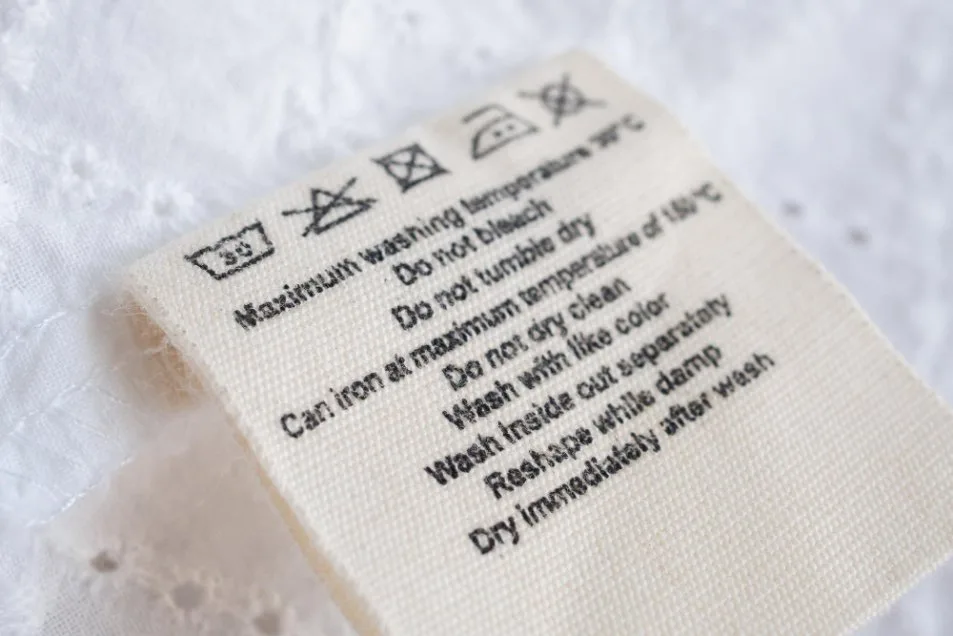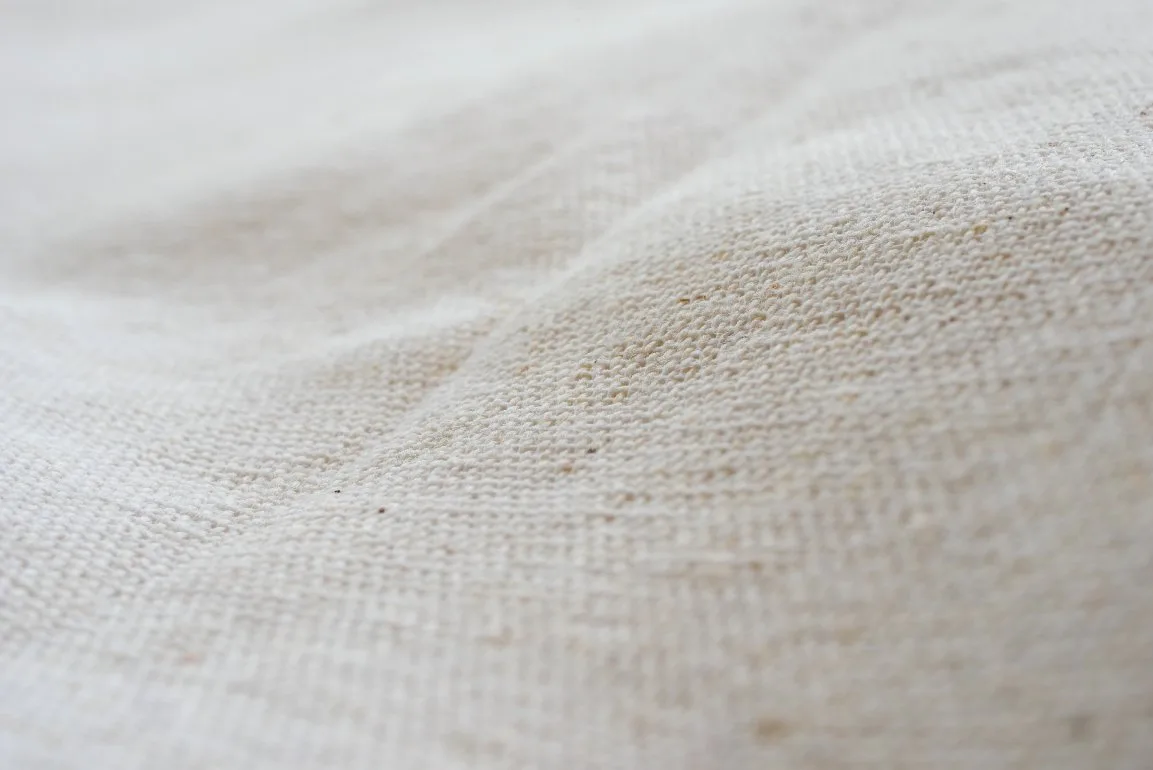Your comprehensive resource for mastering cotton twill – from selecting the perfect weight to advanced care techniques for professional results
Table of Contents
What is Cotton Twill?
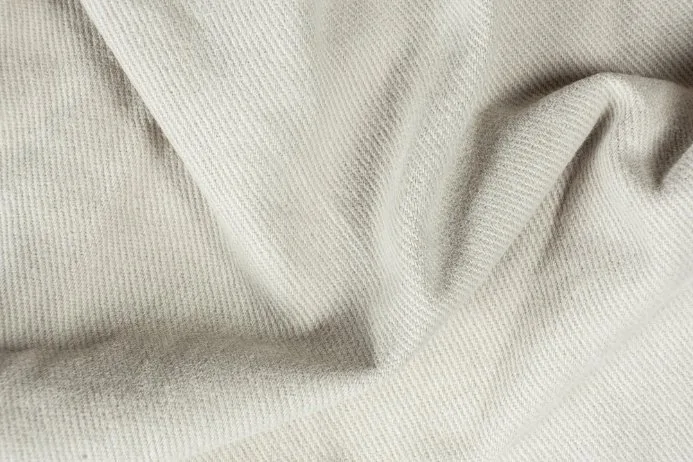
Cotton twill is a durable fabric made from 100% cotton fibers woven in a distinctive diagonal pattern. This diagonal weave creates the characteristic ribbed texture that sets twill apart from plain weave fabrics like cotton poplin or muslin cotton.
Key Point: The diagonal weave pattern in cotton twill is created when the weft (horizontal) threads pass over two or more warp (vertical) threads, then under one, creating a stepped diagonal pattern visible on both sides of the fabric.
How Cotton Twill Differs from Regular Cotton
While both fabrics use 100% cotton fibers, the key difference lies in the weave structure:
| Feature | Cotton Twill | Plain Weave Cotton |
|---|---|---|
| Weave Pattern | Diagonal ribbing | Over-under alternating |
| Durability | Higher | Lower |
| Drape | Structured, holds shape | Softer, more flexible |
| Wrinkle Resistance | Excellent | Moderate |
| Thickness | Generally thicker | Varies widely |
Is Cotton Twill Natural or Synthetic?
Cotton twill is completely natural when made from 100% cotton fibers. The fabric gets its properties from the weave structure, not synthetic additives. However, some manufacturers create cotton twill blends with small amounts of elastane (2-5%) for stretch or polyester for easy care.
Characteristics and Features
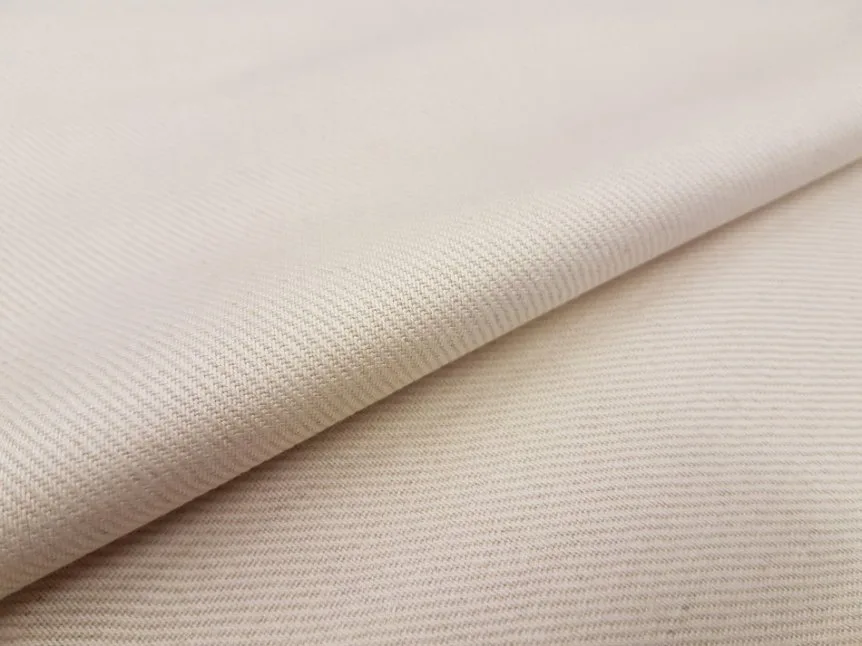
Physical Properties
Cotton twill fabric offers several distinctive characteristics that make it stand out from other common fabric types:
- Diagonal Texture: The signature ribbed pattern creates visual interest and helps hide wear
- Weight Range: Available from 180gsm (lightweight) to 400gsm+ (heavyweight)
- Breathability: Natural cotton fibers allow air circulation
- Moisture Absorption: Absorbs up to 20% of its weight in moisture
- Color Retention: Holds dyes well due to the tight weave structure
Interactive Tools: Use our Fabric Weight Calculator to determine the perfect GSM for your project, or try our Cotton Type Selector Quiz to find your ideal cotton twill match.
What Does Cotton Twill Feel Like?
Cotton twill has a smooth, slightly textured surface that feels substantial in your hands. The diagonal weave creates a subtle ribbed texture that’s pleasant to touch. Compared to plain weave cottons, twill feels:
- More structured and less drapey
- Slightly stiffer when new (softens with washing)
- Denser and more substantial
- Cooler to the touch due to the weave density
Seasonal Performance
Is Twill a Winter or Summer Fabric?
Cotton twill works well in both seasons, depending on the weight:
Lightweight (180-220gsm)
Best for: Spring/summer clothing
Properties: Breathable, comfortable in warm weather
Medium Weight (250-300gsm)
Best for: Year-round wear
Properties: Versatile, works in most climates
Heavyweight (350gsm+)
Best for: Fall/winter garments
Properties: Provides warmth, wind resistance
Does Cotton Twill Keep You Warm?
Cotton twill provides moderate insulation due to its tight weave, which traps air between the fibers. Heavyweight twill (300gsm+) offers good warmth for cool weather, while still allowing breathability. It’s warmer than lightweight cottons but not as insulating as flannel cotton or wool fabrics.
Types and Weights of Cotton Twill
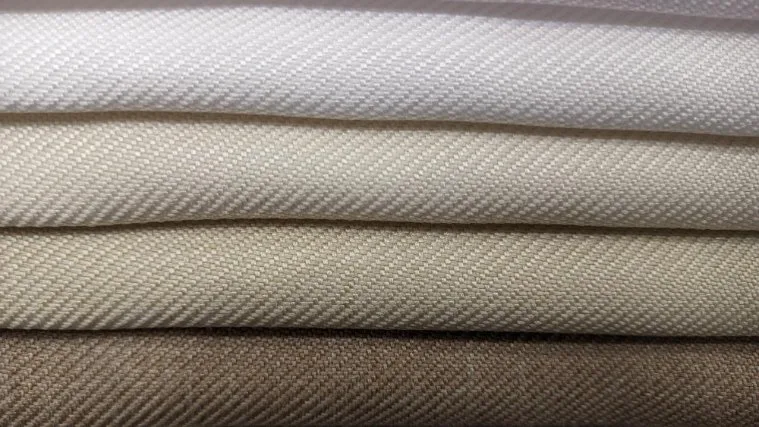
Common Cotton Twill Varieties
Several distinct types of cotton twill serve different purposes:
Chino Twill
Lightweight cotton twill (200-250gsm) originally developed for military uniforms. Perfect for casual pants and summer workwear.
Denim
The most famous cotton twill, typically made with indigo-dyed warp threads. Learn more about the differences between denim and jeans.
Drill Cotton
Heavy-duty twill (300-400gsm) used for workwear, uniforms, and upholstery applications.
Gabardine
Tightly woven twill with a smooth surface, often used for tailored garments and raincoats.
Weight Selection Guide
Pro Tip: Use our Fabric Weight Recommender tool to get personalized GSM recommendations based on your specific project needs.
| Weight Category | GSM Range | Best Applications | Seasonal Use |
|---|---|---|---|
| Lightweight | 180-220gsm | Shirts, blouses, linings | Spring/Summer |
| Medium Weight | 250-300gsm | Dresses, skirts, casual pants | Year-round |
| Heavy Weight | 350-450gsm | Jackets, upholstery, workwear | Fall/Winter |
| Extra Heavy | 500gsm+ | Industrial use, heavy upholstery | Specialized applications |
Advantages and Disadvantages of Cotton Twill
Advantages
- Exceptional Durability: The diagonal weave distributes stress evenly, preventing tears
- Wrinkle Resistance: Natural resistance to creasing saves time on maintenance
- Color Retention: Tight weave holds dyes better than plain weaves
- Stain Resistance: Smooth surface allows easy cleaning
- Professional Appearance: Maintains crisp, structured look
- Versatile Weight Options: Available in multiple thicknesses
- Natural Breathability: 100% cotton allows air circulation
- Easy to Sew: Stable fabric that doesn’t shift during construction
Disadvantages
- Initial Stiffness: Can feel rigid when new (softens with use)
- Shrinkage Potential: May shrink 2-5% without pre-treatment
- Higher Cost: Generally more expensive than plain weave cottons
- Limited Drape: Less fluid than lightweight fabrics
- Slower Drying: Dense weave retains moisture longer
- Color Fading: Dark colors may fade over time with washing
- Weight Considerations: Heavier options may feel bulky
Is Cotton Twill High Quality?
Cotton twill is considered a premium fabric due to its construction complexity and performance characteristics. Quality indicators include:
- Thread Count: Higher thread counts (200+ threads per inch) indicate better quality
- Fiber Length: Long-staple cotton produces superior twill
- Weave Consistency: Even diagonal pattern without irregularities
- Color Fastness: Quality twill maintains color through multiple washes
Applications and Uses
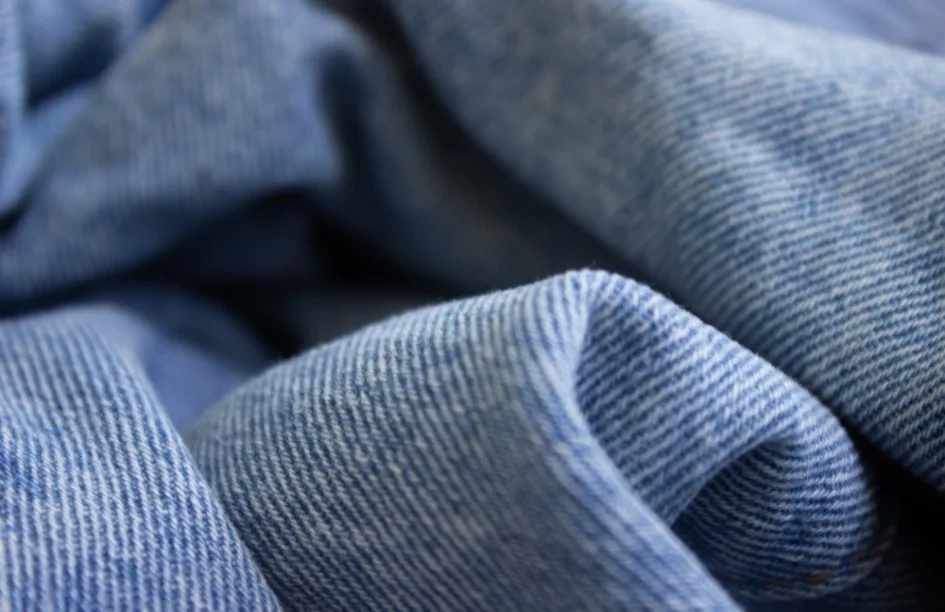
Fashion and Apparel
What is Twill Fabric Good for in Clothes?
Cotton twill excels in structured garments that need to maintain their shape:
- Chino Pants: The classic application for lightweight twill
- Work Shirts: Durability meets professional appearance
- Blazers and Jackets: Provides structure without stiffness
- Skirts and Dresses: Maintains silhouette while allowing movement
- Uniforms: Withstands frequent washing and wear
For sewing enthusiasts, cotton twill works well for dress construction and pairs beautifully with beginner-friendly sewing patterns.
Is Twill a Casual Fabric?
Cotton twill bridges casual and formal wear excellently. Its versatility allows it to work in:
- Casual Settings: Weekend chinos, casual shirts
- Business Casual: Office-appropriate pants and blouses
- Smart Casual: Structured dresses and tailored pieces
Home Décor Applications
Cotton twill’s durability makes it excellent for home projects:
- Upholstery: Chair seats, cushion covers, headboards
- Drapery: Curtains that maintain their shape
- Bedding: Duvet covers and pillow shams
- Table Linens: Placemats and runners that resist wrinkles
Industrial and Specialized Uses
- Workwear: Coveralls, aprons, protective clothing
- Bags and Accessories: Tote bags, backpacks, pouches
- Canvas Alternative: Similar durability with better drape
- Craft Projects: Quilting, embroidery backing
Project Planning: Use our Fabric Selector Tool to determine if cotton twill is right for your specific project, or try our Fabric Yardage Calculator to determine how much you need.
Is Cotton Twill Like Canvas?
Cotton twill shares some similarities with canvas but has key differences:
| Property | Cotton Twill | Canvas |
|---|---|---|
| Weave | Diagonal twill | Plain weave |
| Drape | Better drape | Stiffer |
| Durability | Excellent | Excellent |
| Weight Range | 180-500gsm | 300-800gsm |
| Applications | Apparel and home décor | Heavy-duty uses |
Cotton Twill vs Other Fabrics
Cotton Twill vs Regular Cotton
The main differences lie in construction and performance:
- Durability: Twill lasts 40-60% longer than plain weave cotton
- Wrinkle Resistance: Twill requires 50% less ironing
- Structure: Twill maintains shape better in garments
- Cost: Twill typically costs 20-30% more
Cotton Twill vs Denim
Both are cotton twill, but with different characteristics:
| Feature | Standard Cotton Twill | Denim |
|---|---|---|
| Weight | 180-400gsm | 300-500gsm |
| Dyeing | Piece-dyed | Yarn-dyed (typically indigo) |
| Stiffness | Moderate | Initially very stiff |
| Fading | Minimal | Intentional fading |
| Applications | Diverse | Primarily jeans/jackets |
Which is Better: Cotton or Twill?
The choice depends on your specific needs:
Choose Cotton Twill When: You need durability, wrinkle resistance, and structured appearance. Perfect for workwear, tailored garments, and home décor.
Choose Plain Cotton When: You want softness, drape, and lower cost. Better for casual wear, bedding, and projects requiring fluid movement.
Decision Helper: Our Cotton vs Polyester Comparison Tool can help you understand how cotton twill compares to synthetic alternatives.
Care and Maintenance
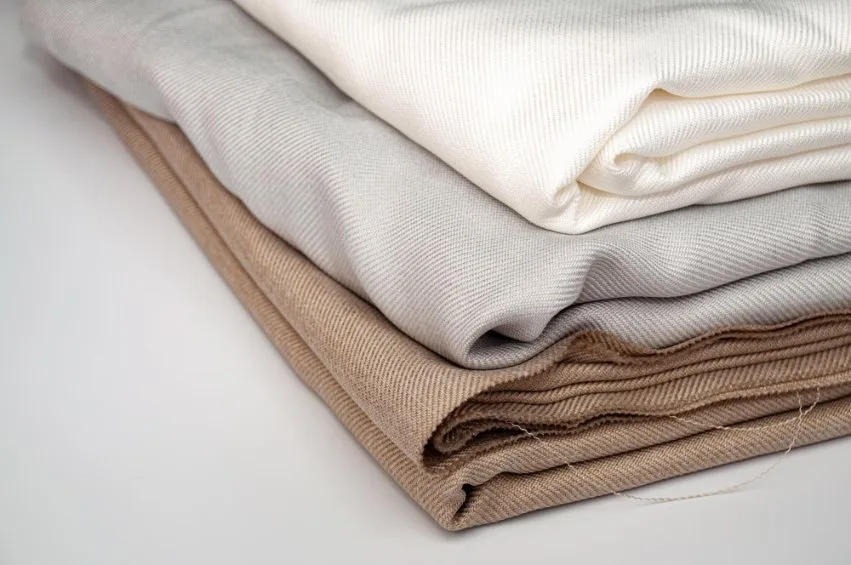
Pre-Care Considerations
Does Cotton Twill Shrink Easily?
Cotton twill can shrink 2-5% on first wash if not pre-shrunk. The tight weave actually helps minimize shrinkage compared to looser cotton weaves. To prevent shrinkage:
- Pre-wash fabric before sewing projects
- Use cold water for first several washes
- Air dry or use low heat settings
- Look for “pre-shrunk” labels when purchasing
Will Twill Shrink When Washed?
After the initial shrinkage, properly cared-for cotton twill should experience minimal additional shrinkage (less than 1%) in subsequent washes.
Cotton Twill Care Flowchart
Check manufacturer’s specific instructions
Apply stain remover and let sit for 10-15 minutes
Cold water (30°C/86°F) for colors
Warm water (40°C/104°F) for whites
Air dry preferred
Low heat tumble dry acceptable
Medium-high heat (150°C/300°F)
Iron on wrong side to prevent shine
Detailed Care Instructions
Washing
- Temperature: Cold to warm water (30-40°C)
- Detergent: Standard laundry detergent, avoid bleach
- Cycle: Normal or gentle cycle
- Load Size: Don’t overcrowd the machine
Drying
- Preferred: Line dry away from direct sunlight
- Machine Dry: Low to medium heat setting
- Remove Promptly: To minimize wrinkles
Ironing and Pressing
- Temperature: Medium-high heat (cotton setting)
- Steam: Light steam helps with stubborn wrinkles
- Technique: Iron on the wrong side to prevent shine
- Pressing Cloth: Use for dark colors
Care Assistant: Use our Cotton Care Calculator for personalized washing instructions based on your specific fabric weight and color.
For comprehensive fabric care guidance, check our complete fabric care guide which covers cotton twill alongside other common textiles.
Buying Guide and Selection Criteria

Quality Assessment
How to Tell if a Fabric is Twill
Identifying cotton twill is straightforward once you know what to look for:
- Visual: Look for the diagonal ribbing pattern on both sides
- Touch: Feel the structured, substantial hand of the fabric
- Drape Test: Twill holds its shape rather than falling softly
- Edge Examination: Check the selvage for tight, even weave
Key Selection Factors
Weight Considerations
How Heavy is Twill Fabric?
Cotton twill weight varies significantly based on intended use:
- Lightweight: 180-220gsm – feels similar to dress shirt fabric
- Medium Weight: 250-300gsm – comparable to sturdy cotton poplin
- Heavy Weight: 350-450gsm – similar to thick denim
- Industrial Weight: 500gsm+ – canvas-like feel
Is Cotton Twill Stiff?
New cotton twill can feel stiff, especially heavier weights. This stiffness serves important purposes:
- Provides structure in tailored garments
- Helps fabric maintain shape during construction
- Softens significantly after 2-3 washes
- Can be pre-softened through washing before sewing
Color and Finish Options
Modern cotton twill comes in extensive color ranges and finishes:
- Solid Colors: From classic neutrals to vibrant 2025 trend colors like deep emerald and rust
- Finishes: Brushed for softness, mercerized for shine, or enzyme-washed for vintage feel
- Performance Treatments: Water-resistant, stain-resistant, or UV-protective finishes
- Eco Options: Organic, recycled, or low-impact dyed varieties
Cost Considerations
Is Cotton Twill Expensive?
Cotton twill typically costs 20-40% more than plain weave cotton due to its complex construction. Price factors include:
- Cotton Quality: Long-staple cotton increases cost but improves durability
- Weight: Heavier fabrics require more cotton, increasing price
- Finishing: Special treatments add to manufacturing costs
- Brand/Source: Designer or specialty mills command premium prices
Why is Twill So Expensive?
Several factors contribute to twill’s higher cost:
- Complex Weaving: Diagonal pattern requires specialized looms and slower production
- Higher Thread Count: More threads per square inch than plain weaves
- Quality Cotton: Better cotton fibers needed to achieve proper twill structure
- Finishing Processes: Additional treatments for optimal performance
- Lower Production Volumes: Less common than plain weaves, creating economy of scale issues
Cost Planning: Use our Fabric Cost Calculator to compare cotton twill prices with alternatives and calculate total project costs.
Where to Buy Quality Cotton Twill
- Specialty Fabric Stores: Best selection and expert advice
- Online Retailers: Wider variety, competitive pricing
- Wholesale Suppliers: Bulk discounts for large projects
- Local Mills: Custom colors and weights possible
2025 Trends and Innovations
Sustainability Developments
The cotton twill market is evolving rapidly with new sustainable innovations:
Eco-Friendly Production Methods
- Regenerative Cotton: Farming practices that restore soil health
- Water-Efficient Processing: New dyeing methods using 95% less water
- Closed-Loop Manufacturing: Recycling process water and chemicals
- Organic Certification: GOTS-certified organic cotton twill growing in popularity
Recycled and Upcycled Options
According to industry reports, the recycled textile market is projected to grow at 3.6% annually through 2033. Cotton twill innovations include:
- Post-Consumer Recycled: Made from recycled cotton garments
- Pre-Consumer Waste: Utilizing manufacturing waste streams
- Fiber-to-Fiber Recycling: Advanced chemical recycling maintaining quality
- Deadstock Utilization: Repurposing excess inventory from manufacturers
Color and Pattern Trends for 2025
Fashion forecasters predict these cotton twill color trends for 2025:
- “Nocturne” Deep Colors: Rich burgundy, forest green, navy
- Earthy Neutrals: Rust, sage green, warm taupe
- Bold Geometrics: Large-scale patterns making a comeback
- Cultural Inspirations: African wax print influences, Japanese indigo techniques
Smart Textile Integration
According to Grand View Research, the global textile market is experiencing significant technological advancement, with smart textiles becoming a major trend. Advanced cotton twill now incorporates cutting-edge technology:
- Moisture-Wicking Treatments: Enhanced performance for activewear using advanced fiber treatments
- UV Protection: Built-in sun protection reaching UPF 30+ ratings for outdoor applications
- Antimicrobial Finishes: Silver-ion technology providing lasting odor resistance and hygiene benefits
- Temperature Regulation: Phase-change materials that adapt to body temperature for enhanced comfort
- Conductive Fibers: Integration with sensors for health monitoring in wearable technology
- Smart Color-Changing: Thermochromic treatments that respond to temperature changes
The Textile Exchange Materials Market Report 2024 shows that technological innovation is driving the industry toward more functional and responsive fabrics, with cotton twill being at the forefront of these developments.
Manufacturing Innovations
According to industry analysis from StartUs Insights, AI and automation are revolutionizing cotton twill production with remarkable results:
- AI Quality Control: Machine vision systems detecting fabric defects at speeds up to 200 meters per minute with 99.9% accuracy
- Automated Weaving: Precision manufacturing reducing material waste by up to 25% compared to traditional methods
- Digital Color Matching: Exact color reproduction across batches using spectral analysis technology
- Predictive Maintenance: IoT sensors monitoring loom performance to prevent downtime and ensure consistent quality
- Robotic Material Handling: Automated fabric handling systems improving efficiency and reducing contamination
- Real-Time Analytics: Production monitoring systems providing instant feedback on quality metrics
The global AI market in textiles is expected to reach $21.4 billion by 2033, growing at 24.6% annually. These technological advances are making cotton twill more consistent, affordable, and environmentally responsible.
Expert Insights and Industry Perspectives
Troubleshooting Guide
Common Cotton Twill Problems and Solutions
Problem: Fabric Puckering During Sewing
Causes: Wrong needle size, incorrect thread tension, or stretching during sewing
Solutions:
- Use size 14/90 needle for medium weight, 16/100 for heavy weight
- Adjust thread tension to match fabric weight
- Support fabric properly while sewing
- Use appropriate presser foot pressure
For detailed sewing guidance, see our sewing machine troubleshooting guide and learn about proper seam allowances.
Problem: Color Fading After Washing
Causes: Water temperature too high, wrong detergent, or poor-quality dyes
Solutions:
- Use cold water (30°C) for first several washes
- Add color-safe bleach alternative
- Turn garments inside out
- Separate colors, especially reds and darks
Problem: Excessive Shrinkage
Prevention:
- Pre-wash fabric before cutting
- Check care labels carefully
- Use appropriate water temperature
- Air dry when possible
Problem: Stiff Hand Feel
Solutions:
- Add fabric softener to final rinse
- Tumble dry with dryer balls
- Iron while slightly damp
- Allow natural softening through wear
Is Cotton Twill See-Through?
Cotton twill opacity depends on weight and construction:
- Lightweight (under 200gsm): May be slightly transparent in bright light
- Medium Weight (250-300gsm): Generally opaque for most applications
- Heavy Weight (350gsm+): Completely opaque
Test opacity by holding fabric up to light or checking against your hand.
Real-World Success Stories
Featured Community Projects
Industry Certifications and Standards
Quality cotton twill should meet established industry standards:
- OEKO-TEX Standard 100: Ensures fabric is tested for harmful substances
- GOTS (Global Organic Textile Standard): Certifies organic fiber content and environmental criteria
- Better Cotton Initiative: Promotes sustainable cotton farming practices
- ISO 9001:2015: Quality management systems for consistent production
- ASTM Standards: Specific test methods for durability, colorfastness, and performance
Frequently Asked Questions
Conclusion
Cotton twill stands as one of the most reliable and versatile fabrics in today’s textile landscape. According to industry data, the global twill fabric market reached approximately $50 billion in 2025, with cotton twill representing the largest segment due to its superior balance of durability, comfort, and professional appearance.
Throughout this comprehensive guide, we’ve explored how cotton twill’s unique construction makes it suitable for applications ranging from casual chinos and professional workwear to home décor and heavy-duty industrial uses. The fabric’s ability to maintain structure while remaining breathable positions it perfectly for both seasonal and year-round applications.
Key Takeaways
For Fashion Applications: Cotton twill excels in structured garments where durability and appearance matter. Choose lightweight weights (180-220gsm) for shirts and summer wear, medium weights (250-300gsm) for pants and dresses, and heavy weights (350gsm+) for jackets and outerwear.
For Home Projects: The fabric’s resistance to wear and easy maintenance make it ideal for upholstery, curtains, and table linens. Its wrinkle resistance means less maintenance compared to plain weave alternatives.
For Sewing Enthusiasts: Cotton twill’s stability during construction makes it forgiving for beginners while offering professional results. Remember to pre-wash, use appropriate needles (14/90 for medium weight), and consider the fabric’s structure when planning your projects.
Sustainability Considerations: With 2025’s focus on environmental responsibility, look for GOTS-certified organic cotton twill or recycled options. The fabric’s durability inherently supports sustainable fashion by lasting longer than less robust alternatives.
Care and Longevity: Proper care significantly extends cotton twill’s lifespan. Cold water washing, appropriate drying methods, and correct ironing techniques ensure your investment in quality fabric pays dividends over time.
Investment Value: While cotton twill costs 20-40% more than plain weave cotton, its superior durability, professional appearance, and low maintenance requirements often justify the initial price difference through extended wear life and reduced replacement needs.
Looking Forward
As textile technology advances, cotton twill continues evolving with smart treatments, sustainable production methods, and innovative finishing techniques. Whether you’re crafting a professional wardrobe, updating your home décor, or starting your first sewing project, cotton twill offers the reliability and versatility to meet your needs while supporting both style and sustainability goals.
The fabric’s enduring popularity across fashion, interior design, and industrial applications demonstrates its fundamental value. By understanding its properties, care requirements, and applications, you can make informed decisions that result in successful projects and long-lasting satisfaction with your textile choices.


